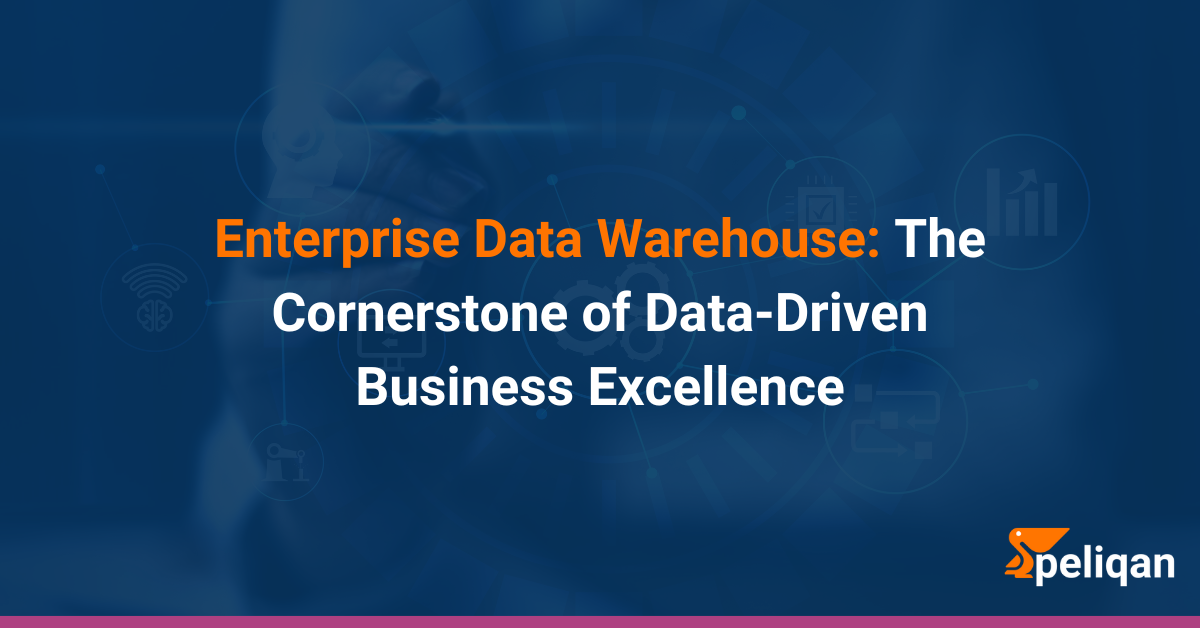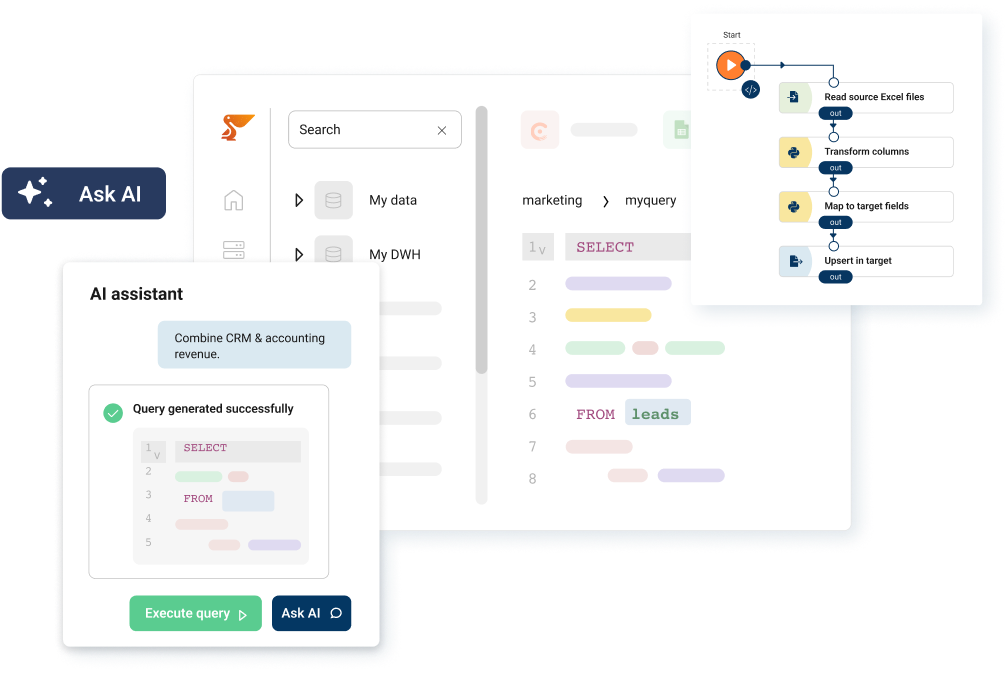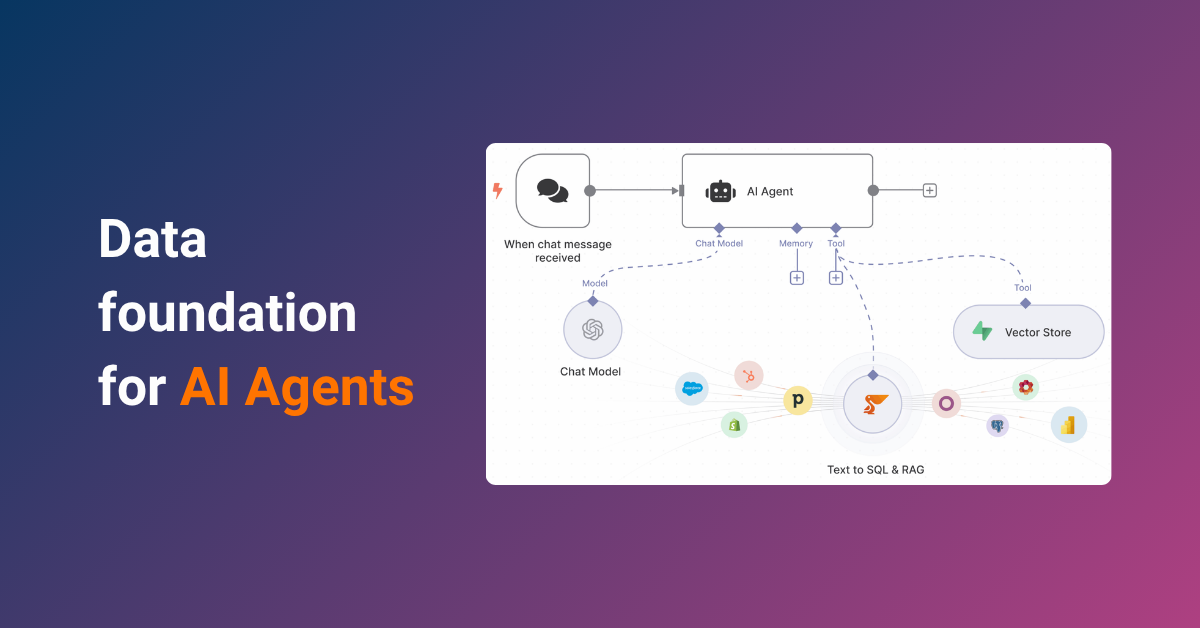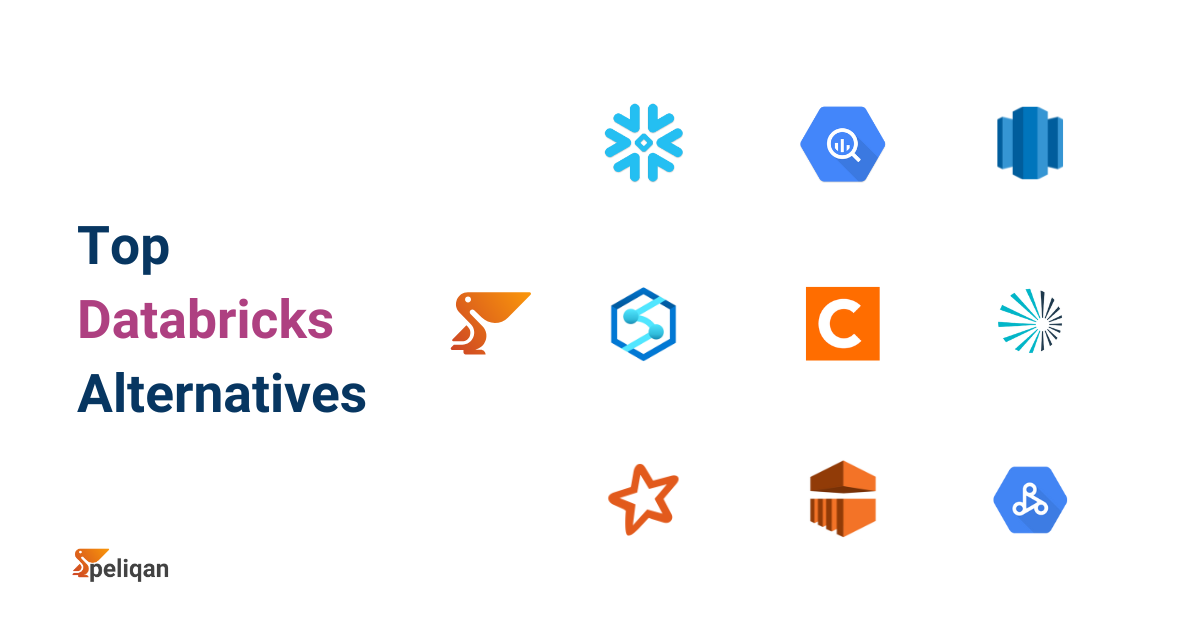In today’s data-driven business landscape, an Enterprise Data Warehouse (EDW) stands as a critical component for organizations seeking to harness the full potential of their information assets. An EDW serves as a centralized repository that consolidates data from various sources across an entire organization, providing a single source of truth for decision-making and analytics.
As businesses generate and collect vast amounts of data daily, the need for robust Enterprise Data Warehouse solutions has never been more pressing. These sophisticated systems enable companies to store, manage, and analyze large volumes of structured and semi-structured data, transforming raw information into actionable insights that drive strategic decision-making and operational efficiency.
This comprehensive guide explores the intricacies of Enterprise Data Warehouses, their types, benefits, challenges, and the technologies that power them. Whether you’re a business leader considering implementing an EDW or a data professional looking to optimize your existing warehouse, this article will provide valuable insights into the world of enterprise-scale data management.
Key topics we’ll cover:
- Definition and importance of EDW data
- Types of EDWs and their unique characteristics
- Benefits and challenges of implementing an EDW
- Essential EDW technologies and platforms
- Best practices for building and maintaining an EDW data
By the end of this guide, you’ll have a thorough understanding of how Enterprise Data Warehouses can transform your organization’s data management strategy and unlock new opportunities for growth and innovation.
What is an EDW (Enterprise Data Warehouse)?
An Enterprise Data Warehouse (EDW) is more than just a repository; it’s a sophisticated ecosystem designed to store, manage, and analyze data from across an entire organization. Unlike departmental or smaller-scale data warehouses, an EDW serves as a centralized hub for all business data, providing a single source of truth for decision-making and analytics.
The global market for Enterprise Data Warehouse (EDW) was estimated at $14 Billion in 2023 and is projected to reach 71.5 Billion dollars by 2030, growing at a CAGR of 26.3% from 2023 to 2030.
EDWs are engineered to handle massive volumes of structured and semi-structured data from diverse sources. They employ advanced technologies and architectures to ensure data integrity, accessibility, and performance at scale. By consolidating data from various business units and external sources, EDWs eliminate information silos and foster a unified view of the organization’s data landscape.
DWh vs EDW
While the terms “data warehouse (DWh)” and “EDW (Enterprise Data Warehouse)” are often used interchangeably, there are significant differences in their scope, scale, and complexity. Understanding these distinctions is crucial for organizations considering their data management strategy.
A traditional data warehouse typically serves a specific department or business function, focusing on a subset of the organization’s data. In contrast, an EDW encompasses data from the entire enterprise, providing a holistic view of the business. This broader scope allows for more comprehensive analytics and cross-functional insights.
Scope
Think of a data warehouse as a departmental filing cabinet. It focuses on a specific area of the business, like sales or marketing, storing relevant data from that department’s systems. An EDW, however, is like a company-wide archive. It consolidates data from all departments and external sources, offering a comprehensive view of the entire organization.
Scale
Data warehouses typically handle smaller data volumes tailored to a department’s needs. EDWs, on the other hand, are built to manage massive datasets encompassing the whole enterprise. This allows them to support complex queries that analyze data across departments, revealing hidden trends and patterns.
Integration
Data warehouses often deal with data from internal departmental systems. EDWs go a step further, integrating data from a wider range of sources. This includes legacy systems, external databases, and even social media feeds. This broader integration provides a richer picture of the business and its external environment.
Complexity
Data warehouses generally have a simpler architecture designed for specific departmental needs. EDWs, however, have a more sophisticated architecture to handle the complexities of enterprise-wide data. This includes advanced data modeling techniques to organize and structure the vast amount of information, as well as robust data governance features to ensure data quality, security, and compliance across the organization.
Governance
Since data warehouses cater to a specific department, data governance is less critical. However, EDWs, containing sensitive information from across the company, require more robust data governance policies. These policies ensure data accuracy, consistency, and access control throughout the organization.
Top 7 EDW Benefits
Implementing an Enterprise Data Warehouse can yield transformative benefits for organizations across various industries. By centralizing data management and enabling advanced analytics, EDWs empower businesses to make data-driven decisions with confidence and agility.
The advantages of an EDW extend beyond mere data storage. They serve as a foundation for business intelligence initiatives, support regulatory compliance efforts, and drive operational efficiencies across the organization. Let’s explore some of the key benefits in detail:
1. Centralized Data Management
EDWs function as a central repository, consolidating data from disparate sources across the organization. This eliminates the issue of data silos, where valuable information is fragmented and inaccessible. By providing a single source of truth, EDWs ensure data consistency and facilitate a holistic view of the enterprise.
2. Improved Decision-Making
Imagine having access to a comprehensive and up-to-date data landscape. EDWs make this a reality, granting users the ability to retrieve and analyze relevant information across departments and functions. This empowers businesses to make data-driven decisions with greater confidence and agility, leading to improved strategic planning, resource allocation, and overall performance.
3. Enhanced Data Quality
Data quality is highly significant for reliable insights. EDWs incorporate robust data cleansing and validation processes. These procedures ensure the accuracy and consistency of information within the warehouse, eliminating errors and inconsistencies that can skew analysis and lead to misleading conclusions.
4. Scalability and Future-Proofing
Data volumes are constantly growing. EDWs are architected to scale seamlessly, accommodating increasing data sets as your business expands. This future-proofs your data management infrastructure, ensuring it can handle the ever-growing demands of information analysis.
5. Historical Analysis and Long-Term Insights
EDWs don’t just store current data; they serve as a historical archive. This allows businesses to analyze trends over time, identify patterns, and gain valuable insights into customer behavior, market fluctuations, and operational performance. These historical perspectives are crucial for informed decision-making and strategic planning for the long term.
6. Compliance and Security
In today’s regulatory environment, data security and compliance are paramount concerns. EDWs centralize data management, facilitating better access control, security protocols, and audit trails. This simplifies compliance efforts and mitigates the risk of data breaches or regulatory violations.
7. Cost Efficiency and Resource Optimization
By consolidating data storage and processing, EDWs can significantly reduce IT costs. Redundant data storage across departments is eliminated, and resources are streamlined for improved efficiency. This translates to cost savings that can be reinvested in further data analytics initiatives or other strategic areas.
Enterprise Data Warehouse Architecture
The architecture of an Enterprise Data Warehouse (EDW) is a critical factor in its success, ensuring scalability, performance, and flexibility. A well-designed EDW architecture allows organizations to adapt to changing business needs and technological advancements. EDW architectures typically follow a layered approach, with each layer serving a specific purpose in the data management and analytics process.
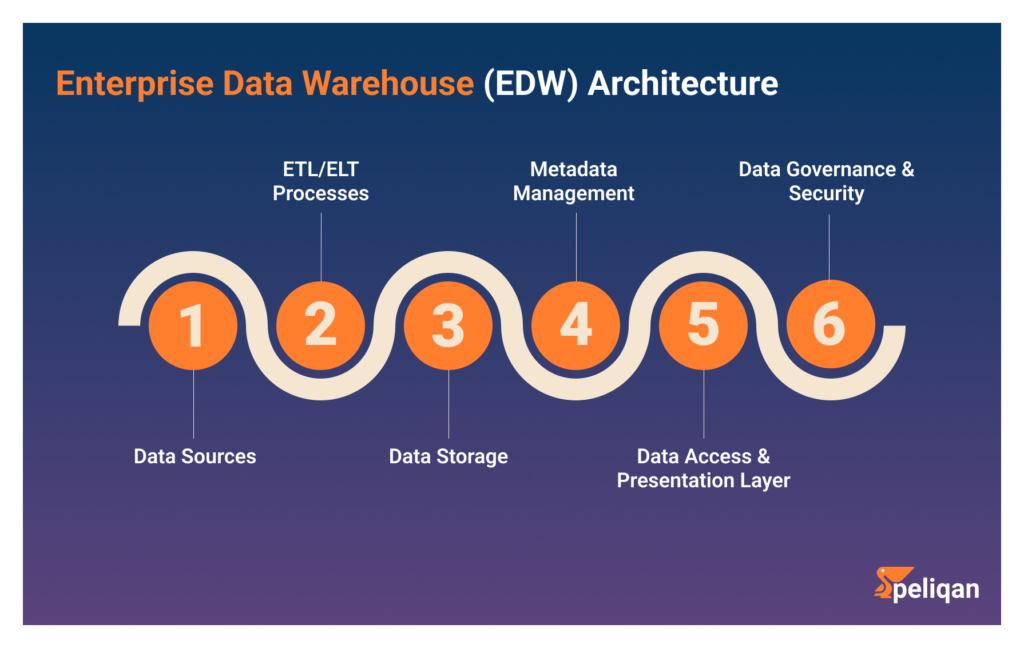
Data Sources
Data sources form the foundation of an EDW, encompassing a wide range of internal and external data inputs. These include internal systems such as ERP and CRM platforms, which provide crucial operational data. External sources like market data providers, social media platforms, and third-party APIs contribute valuable contextual information.
The integration of IoT devices and sensors further expands the data landscape, offering real-time insights into physical processes and environments. Unstructured data sources, including documents, emails, and system logs, round out the comprehensive data ecosystem that feeds into the EDW.
ETL/ELT Processes
Extract, Transform, Load (ETL) or Extract, Load, Transform (ELT) processes are the backbone of data integration in an EDW. These processes are responsible for retrieving data from various sources, cleansing and transforming it to fit the target schema, and loading it into the warehouse.
Modern ELT approaches leverage the processing power of target systems, allowing for more flexible and scalable data transformation. These processes ensure that data entering the EDW is consistent, accurate, and properly formatted for analysis.
Data Storage
The data storage layer of an EDW typically utilizes relational databases optimized for analytical workloads. Many modern EDWs employ columnar storage techniques to improve query performance, particularly for large-scale data sets.
Data marts, which are subsets of the warehouse focused on specific business units or functional areas, provide tailored access to relevant data. Staging areas for raw and intermediate data facilitate the ETL/ELT process and support data lineage tracking.
Metadata Management
Metadata management is crucial for providing context and meaning to the data stored in the EDW. This layer encompasses business metadata, which includes definitions, ownership information, and business context for data elements.
Technical metadata covers data structures, ETL mappings, and data lineage, crucial for understanding data transformations. Operational metadata, including job logs, data quality metrics, and usage statistics, supports the ongoing management and optimization of the EDW.
Data Access and Presentation Layer
The data access layer serves as the interface between the EDW and its users, providing various methods for querying and analyzing data. This includes SQL interfaces for ad-hoc querying, OLAP cubes for multidimensional analysis, and APIs for application integration.
Data visualization tools integrated into this layer enable the creation of reports and dashboards, making complex data accessible to business users. The design of this layer significantly impacts the usability and value derived from the EDW.
Data Governance and Security
Data governance in an EDW encompasses tools and processes to ensure data quality, security, and compliance throughout the data lifecycle. This includes implementing data quality management tools to maintain the integrity of the data warehouse. Robust security and access control mechanisms protect sensitive information and ensure appropriate data usage.
Modern Enterprise Data Warehouse architectures often incorporate cloud technologies, allowing for greater flexibility and scalability. Hybrid architectures, combining on-premises and cloud components, are also common, enabling organizations to leverage existing investments while taking advantage of cloud benefits.
When designing your Enterprise Data Warehouse architecture, consider factors such as data volume, variety, and velocity, as well as your organization’s specific analytical needs and regulatory requirements. A well-architected EDW provides a solid foundation for data-driven decision-making and business intelligence initiatives.
Types of EDW
The landscape of Enterprise Data Warehousing has evolved significantly, with new technologies and deployment models emerging to meet diverse business needs. Each type of EDW offers unique advantages and considerations, from traditional on-premises solutions to modern cloud-based and hybrid approaches.
| EDW Type | Scalability | Initial Cost | Maintenance | Data Control | Best For |
|---|---|---|---|---|---|
| On-Premises | Limited | High | Complex | High | Organizations with strict data sovereignty requirements |
| Cloud-Based | High | Low | Simple | Moderate | Organizations seeking scalability and cost-efficiency |
| Hybrid | High | Moderate | Moderate | High | Organizations balancing existing infrastructure with cloud benefits |
| Virtual | Moderate | Low | Simple | Varies | Organizations with distributed data sources |
| Data Lakehouse | Very High | Moderate | Moderate | High | Organizations requiring flexibility for diverse data types and advanced analytics |
As an emerging technology, best practices for data lakehouses are still evolving. Organizations adopting this approach should be prepared to address potential complexities in data governance and schema management.
Challenges of Enterprise Data Warehouses
While Enterprise Data Warehouses offer numerous benefits, implementing and maintaining an EDW is not without its challenges. Organizations must be prepared to address these obstacles to ensure the success of their EDW initiatives. Understanding these challenges is crucial for developing effective data strategies to mitigate risks and maximize the value of your EDW investment.
Data Integration
Integrating data from diverse sources is one of the most significant challenges in EDW implementation. Organizations often deal with a multitude of data sources, each with its own format, schema, and update frequency. The complexity of data integration increases with the number and variety of sources, requiring sophisticated ETL processes and data mapping strategies.
Ensuring data consistency and managing data transformations across these diverse sources can be time-consuming and resource-intensive. Additionally, handling real-time data integration alongside batch processes adds another layer of complexity to the integration challenge.
Data Quality
Maintaining consistent data quality across the enterprise is an ongoing challenge that requires robust processes and continuous effort. Poor data quality can undermine the credibility and usefulness of the entire EDW. Organizations must implement comprehensive data quality management strategies, including data profiling, cleansing, and validation at various stages of the data pipeline.
Establishing and enforcing data quality standards across different departments and systems can be particularly challenging, especially in large enterprises with decentralized data management practices. Automated data quality monitoring and remediation tools are often necessary to manage this challenge effectively.
Scalability
As data volumes grow exponentially, maintaining performance and managing costs become increasingly challenging. EDWs must be designed to handle not only current data volumes but also anticipated future growth. This requires careful capacity planning and the implementation of scalable architectures.
Cloud-based EDW solutions offer more flexibility in scaling, but they come with their own challenges related to cost management and performance optimization. Organizations must also consider the scalability of their data integration processes, query performance, and analytical capabilities as data volumes increase.
Security and Compliance
Protecting sensitive data and meeting regulatory requirements in a centralized system requires careful planning and ongoing management. EDWs often contain critical business data and personally identifiable information, making them attractive targets for cyber attacks. Implementing robust security measures, including encryption, access controls, and auditing mechanisms, is essential.
Compliance with regulations such as GDPR, NIS2, or industry-specific standards adds another layer of complexity. Organizations must ensure that their EDW architecture supports data privacy, retention policies, and the right to be forgotten, among other compliance requirements.
Adoption and Change Management
Encouraging organization-wide adoption of the EDW and associated tools can be a significant undertaking. Resistance to change, lack of data literacy, and preference for existing systems can hinder EDW adoption. Organizations must invest in comprehensive training programs and change management initiatives to ensure that users across different departments understand the value of the EDW and are equipped to use it effectively.
Developing a data-driven culture and aligning EDW capabilities with business processes and objectives are crucial for successful adoption. Additionally, managing the transition from legacy systems to the new EDW environment requires careful planning and execution to minimize disruption to business operations.
5 Business Needs that Require an EDW
As organizations grow and evolve, certain business needs emerge that can be effectively addressed through the implementation of an Enterprise Data Warehouse (EDW). Recognizing these needs is crucial for organizations considering EDW adoption. Here are five key areas where an EDW can provide significant value:
1. Business Intelligence and Analytics
Purpose: Provides a foundation for advanced analytics
Benefits:
- Enables deeper insights into operations, customers, and markets
- Supports data-driven decision making across the organization
- Facilitates complex queries and multidimensional analysis
2. Regulatory Compliance
Purpose: Maintains a centralized, auditable data repository
Benefits:
- Ensures data consistency for accurate reporting
- Streamlines the audit process with comprehensive data lineage
- Enhances data governance and security measures
3. Customer 360-Degree View
Purpose: Integrates data from various customer touchpoints
Benefits:
- Enables a comprehensive understanding of customer behavior
- Enhances personalization in marketing and customer service
- Improves customer retention and lifetime value
4. Operational Efficiency
Purpose: Streamlines business processes across departments
Benefits:
- Provides real-time access to accurate, consistent data
- Reduces data silos and improves interdepartmental collaboration
- Enhances forecasting and resource allocation
5. Data Monetization
Purpose: Leverages data assets for new revenue streams
Benefits:
- Enables the development of data-driven products and services
- Facilitates data sharing with partners and customers
- Supports the creation of industry benchmarks and reports
An EDW addresses these needs by providing a centralized, structured repository for data from various sources, enabling organizations to unlock the full potential of their data assets and drive business growth.
Getting Started with an EDW
Enterprise Data Warehouse initiative requires careful planning, strategic decision-making, and a clear understanding of your organization’s data management needs. While the journey may seem daunting, a well-executed EDW implementation can deliver significant business value and set the foundation for data-driven success.
To help you navigate the process, here are some key steps to consider when getting started with your EDW project:
Define Your Objectives:
Clearly articulate what you want to achieve with your EDW. This involves identifying specific business problems you aim to solve, key performance indicators you want to track, and the types of insights you hope to gain. Engage stakeholders from various departments to ensure your objectives align with overall business goals.
Assess Your Current Data Landscape:
Conduct a thorough inventory of your existing data sources, volumes, and quality. This assessment should include both structured and unstructured data across all relevant systems and departments. Identify data silos, inconsistencies, and quality issues that need to be addressed in your EDW implementation.
Choose Your EDW Solution:
Decide between on-premises, cloud-based, or hybrid solutions based on your needs and constraints. Consider factors such as scalability requirements, budget, existing infrastructure, data security needs, and in-house technical expertise. Evaluate different vendors and technologies to find the best fit for your organization.
Design Your EDW Architecture:
Plan your data model, integration processes, and access methods. This step involves deciding on the appropriate data modeling approach (e.g., star schema, snowflake schema), designing ETL/ELT processes, and determining how users will interact with the data. Consider future scalability and flexibility in your design.
Implement Data Governance:
Establish policies and procedures for data quality, security, and compliance. This includes defining data ownership, setting up data quality checks, implementing access controls, and ensuring compliance with relevant regulations. A robust data governance framework is crucial for maintaining the integrity and usability of your EDW.
Start Small and Scale:
Begin with a pilot project and gradually expand your EDW implementation. Choose a specific business area or use case for your initial implementation. This approach allows you to demonstrate value quickly, learn from the process, and refine your approach before scaling up to the entire organization.
Invest in Training:
Ensure your team has the skills needed to manage and leverage your EDW effectively. This includes training for IT staff on the technical aspects of EDW management, as well as training for business users on how to access and analyze data using the new system. Developing a data-driven culture is key to maximizing the value of your EDW investment.
As you embark on your EDW journey, consider leveraging advanced data management platforms like Peliqan to enhance your implementation. Peliqan offers a comprehensive suite of tools that can significantly streamline your EDW setup and management processes. Its robust data integration capabilities, advanced analytics features, and built-in data governance tools align well with the key steps outlined above.
Peliqan’s scalable architecture and user-friendly interface can help accelerate your EDW implementation, ensuring a faster time-to-value and easier adoption across your organization. Whether you’re just starting out or looking to optimize an existing EDW, Peliqan’s capabilities can provide the support and flexibility needed to drive your data-driven initiatives forward.
Enterprise Data Warehousing Technologies
The technology landscape for Enterprise Data Warehousing is diverse and constantly evolving. Organizations have a wide range of options when it comes to selecting the tools and platforms that will form the foundation of their EDW strategy.
From traditional database management systems to modern cloud-native solutions, the choice of technology can significantly impact the performance, scalability, and cost-effectiveness of your EDW. Let’s explore some of the key technologies in this space:
- Database Management Systems: Oracle, Microsoft SQL Server, IBM Db2, and PostgreSQL for on-premises EDWs.
- Cloud Data Warehouse Platforms: Amazon Redshift, Google BigQuery, Microsoft Azure Synapse Analytics, and Snowflake.
- ETL/ELT Tools: Informatica PowerCenter, Talend, and Apache NiFi for data integration.
- Business Intelligence Tools: Tableau, Power BI, and Looker for data visualization and analytics.
- Data Governance Tools: Collibra, Alation, and Informatica Axon for managing data quality and governance.
Peliqan is an all-in-one data platform that seamlessly integrates data warehousing, ETL processes, and analytics. With Peliqan, organizations can efficiently manage their entire data lifecycle, from ingestion to insights, ensuring high performance and scalability. Its comprehensive suite of tools empowers businesses to harness the full potential of their data.
Why Peliqan is Better Choice for EDW?
Peliqan’s integrated approach combines advanced ETL capabilities, real-time processing, and built-in machine learning features, providing a more holistic solution for organizations looking to maximize the value of their data assets.eliqan is a versatile all-in-one platform designed to meet diverse data management needs effortlessly.

Peliqan integrates seamlessly with business applications, facilitates ETL processes into either its built-in data warehouse or external platforms like Snowflake and BigQuery, and supports a variety of BI tools such as Metabase. It enables quick implementation of data activation strategies such as Reverse ETL, API endpoint publication, alerting, distribution of personalized reports, and live data integration into tools like Excel.
Peliqan.io serves as a unified data solution suitable for business teams, startups, scale-ups, and IT service companies, eliminating the need for dedicated data engineers. Users can easily connect to databases, data warehouses, and SaaS applications, leveraging SQL, low-code Python, and AI capabilities to build data apps, APIs, and syncs within minutes. The platform offers one-click ETL from over 100+ sources, ensuring efficient data transformation and integration.
Key features of Peliqan:
- Connect: ETL capabilities to its built-in data warehouse or external systems.
- Transform: Use SQL or low-code Python for data viewing, combining, and transformation.
- Activate: Implement reporting, alerting, reverse ETL, data export, API publishing, ML model execution, and chatbot development in-house.
Peliqan’s comprehensive functionality and user-friendly interface make it an ideal choice for organizations seeking robust data management solutions without the complexity of traditional data engineering setups.
Conclusion
Enterprise Data Warehouses have become indispensable tools for organizations seeking to harness the full potential of their data assets. By providing a centralized, scalable, and efficient platform for data storage and analysis, EDWs enable businesses to make data-driven decisions, improve operational efficiency, and gain a competitive edge in today’s fast-paced business environment.
As technology continues to evolve, the future of EDWs looks promising, with cloud-based solutions, AI-powered analytics, and real-time data processing pushing the boundaries of what’s possible. Whether you’re just starting your EDW journey or looking to optimize your existing data warehouse, the key is to align your EDW strategy with your business objectives and embrace the transformative power of enterprise-wide data management.
By carefully considering the various aspects of EDW implementation discussed in this guide, organizations can position themselves to leverage their data assets more effectively, drive innovation, and achieve sustainable growth in an increasingly data-centric world.




